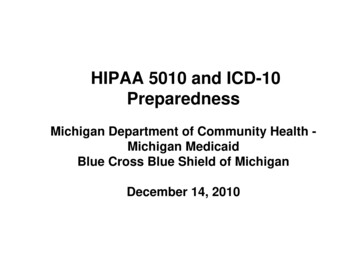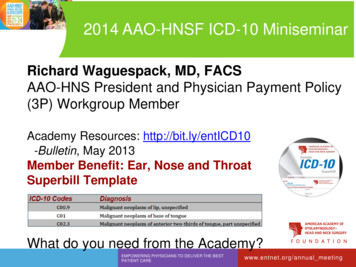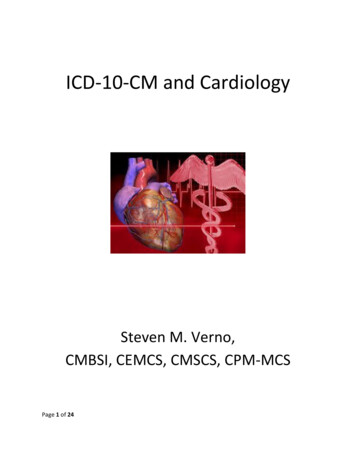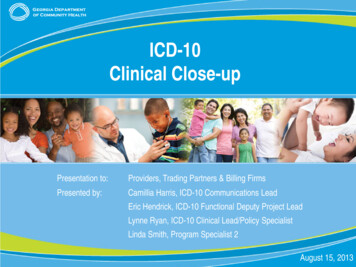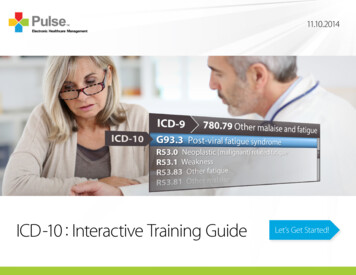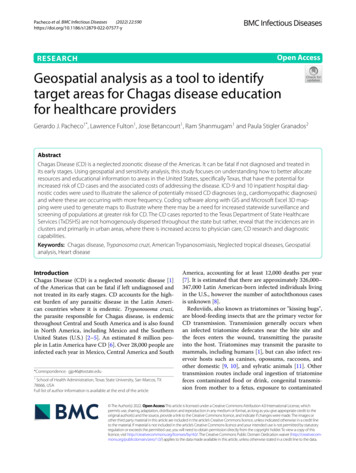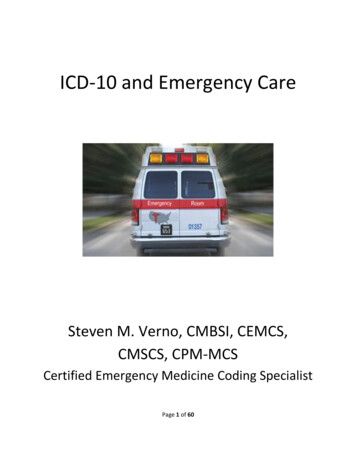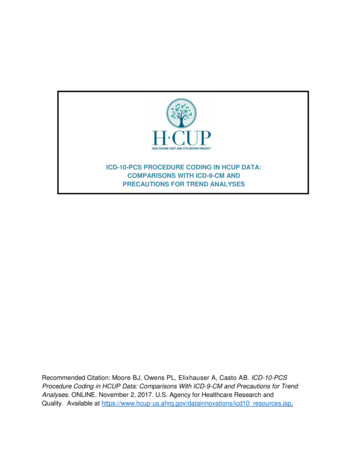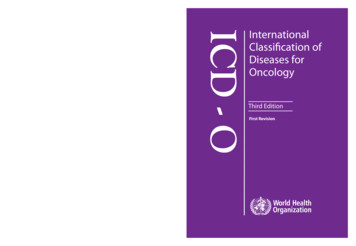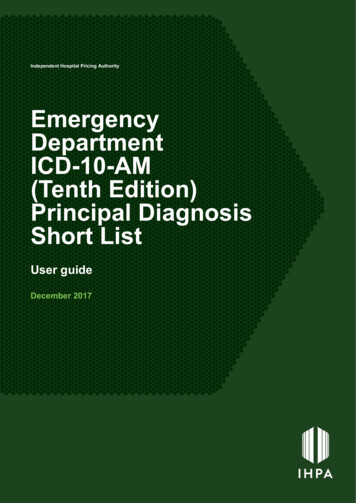
Transcription
Emergency Department ICD-10-AM Principal Diagnosis Short ListIndependent Hospital Pricing AuthorityEmergencyDepartmentICD-10-AM(Tenth Edition)Principal DiagnosisShort ListUser guideDecember 20171
Emergency Department ICD-10-AM Principal Diagnosis Short ListEmergency Department ICD-10-AM Principal Diagnosis Short List Independent Hospital Pricing Authority 2017This publication is available for your use under a Creative Commons BYAttribution 3.0 Australia licence, with the exception of the IndependentHospital Pricing Authority logo, photographs, images, signatures and whereotherwise stated. The full licence terms are available from the CreativeCommons website.Use of Independent Hospital Pricing Authority material under a CreativeCommons BY Attribution 3.0 Australia licence requires you to attribute thework (but not in any way that suggests that the Independent Hospital PricingAuthority endorses you or your use of the work).Independent Hospital Pricing Authority material used 'as supplied'.Provided you have not modified or transformed Independent Hospital PricingAuthority material in any way including, for example, by changing IndependentHospital Pricing Authority text – then the Independent Hospital PricingAuthority prefers the following attribution:Source: The Independent Hospital Pricing Authority2
Emergency Department ICD-10-AM Principal Diagnosis Short ListAbbreviationsCCFCongestive cardiac failureEDEmergency DepartmentED-IDEmergency Department (short list) IdentifierIHPAIndependent Hospital Pricing AuthorityICD-9-CMInternational Classification of Diseases – Ninth Revision– Clinical ModificationICD-10-AMInternational Statistical Classification of Diseases andRelated Health Problems – Tenth Revision – AustralianModificationNAPEDC NMDSNon Admitted Patient Emergency Department CareNational Minimum Data SetNNDSSNational notifiable disease surveillance systemNSTEMINon-ST elevation myocardial infarctionSNOMED CTSystematized Nomenclature of Medicine – ClinicalTermsSTEMIST elevation myocardial infarctionTBITraumatic brain injuryUDGsUrgency Disposition GroupsURGsUrgency Related Groups3
Emergency Department ICD-10-AM Principal Diagnosis Short ListContentsEmergency Department ICD-10-AM (Ninth Edition) Principal DiagnosisList . 1Abbreviations . 31. Purpose . 51.1Background . 51.2Development . 51.3Updating the short list . 62. Components . 72.1ED ICD-10-AM principal diagnosis short list file . 72.2ED ICD-10-AM principal diagnosis short list mapping file . 72.3ED ICD-10-AM principal diagnosis short list hierarchies file . 83. Specific guidelines . 93.1Conventions for terms in the short list . 93.23.33.44.3.1.1Currency . 93.1.2Context . 93.1.3Exclusivity/comprehensiveness . 93.1.4Aggregation . 103.1.5ICD-10-AM convention . 113.1.6General arrangement of terms in the ED short list . 113.1.7Neoplasms . 113.1.8Injuries . 11Included conditions . 12Dagger and asterisk codes . 13General formatting . 133.4.1Abbreviations . 133.4.2Parentheses . 133.4.3Commas . 14Utility. 154
Emergency Department ICD-10-AM Principal Diagnosis Short List1. PurposeThe Emergency Department (ED) International Statistical Classification of Diseases and RelatedHealth Problems - Tenth Revision - Australian Modification (ICD-10-AM) Principal DiagnosisShort List (the short list) is a list of codes and medical terms based on ICD-10-AM Tenth Editionthat aims to provide a nationally consistent approach to principal diagnosis reporting in the ED.A ‘principal diagnosis’ is reported for ED attendances within the Non Admitted PatientEmergency Department Care National Minimum Data Set (NAPEDC NMDS). The NAPEDCNMDS is a minimum set of data elements agreed for mandatory collection by all states andterritories for ED reporting at a national level.The ED principal diagnosis is currently defined as the diagnosis established at the conclusion ofthe patient's attendance in an ED to be mainly responsible for occasioning the attendancefollowing consideration of clinical assessment, as represented by a code.1 Comorbidities andcauses of injuries are not intended to be captured as the principal diagnosis, and can becaptured as secondary data items in other ED collections.1.1 BackgroundIn 2013 the Independent Hospital Pricing Authority (IHPA) initiated a review to assess long termoptions for classification of emergency care services for activity based funding in Australia. Amajor objective of the approach to classifying emergency care services in Australia was to driveefficiency and effectiveness of these services through pricing and funding in conjunction with thecollection of underlying data that supports clinical care and other uses such as qualityimprovement, epidemiological monitoring and health services research.The review recommended development of a new emergency care classification to replace theUrgency Related Groups (URGs) and Urgency Disposition Groups (UDGs) classifications, giventhe lack of support for the ongoing use of triage and a strong interest in moving to a morediagnosis based classification.The short list is a key component of the new emergency care classification, replacinginconsistencies whereby states and territories have developed localised short lists and variouslyreport principal diagnosis using Systematized Nomenclature of Medicine – Clinical Terms(SNOMED CT) and various editions of ICD-10-AM or the International Classification of Diseases– Ninth Revision – Clinical Modification (ICD-9-CM).1.2 DevelopmentThe short list was developed in consultation with ED clinicians and jurisdictions and was subjectto a public consultation.The guiding principles in developing the short list of codes were:1 Australian Institute of Health and Welfare, METeOR metadata online registry (2014). Emergency department stay, principal diagnosis, code X[X(8)].Retrieved 6 March 2017 from Id/4974905
Emergency Department ICD-10-AM Principal Diagnosis Short List sufficient volume of attendances reported for a diagnosis to support the inclusion of a codeconsistent use of the diagnosis codes between jurisdictionscomparability with ICD-10-AM diagnosis codes reported in the admitted settingexhaustive nature of the short list, with appropriate inclusion of residual diagnosis categoriesfor conditions which do not have a specific code in the short listcaptures a clinical diagnosis rather than the cause of injury or a comorbidity, with externalcauses of morbidity and mortality codes (chapter 20) excluded from the short list.The final short list comprises 1134 codes ensuring a sufficient number of codes to be clinicallycomprehensive and meaningful, but practical for clinicians to manage and use effectively.This document is for use primarily by jurisdictions and data managers and details thecomponents of the short list, conventions used and specific guidelines for use. In addition to thisdocument an abridged Quick reference guide for principal diagnosis reporting has beendeveloped for use by clinicians responsible for selecting the principal diagnosis codes.1.3 Updating the short listThe short list was developed using ICD-10-AM Ninth Edition and has now been updated forcompatibility with ICD-10-AM Tenth Edition.Further updates to the short list will be made in conjunction with new editions of ICD-10-AMwhere there will also be an opportunity for jurisdictions and other stakeholders to providefeedback and input into subsequent versions.Any enquiries related to the short list should be directed to (enquiries.ihpa@health.gov.au).6
Emergency Department ICD-10-AM Principal Diagnosis Short List2. Components2.1 ED ICD-10-AM principal diagnosis short list fileThe short list file contains the following columns (in Excel) as per Table 1.Table 1 – ED ICD-10-AM principal diagnosis short list fileColumnColumn HeadingsDefinitionAED-IDUnique identifier for each short list codeBDisease/body system groupDisease/body system group for aggregation of maindisease groups regardless of where they arecategorised in ICD-10-AMCICD-10-AM chapterICD-10-AM chapter number where the code residese.g. ‘6’ indicates the code is found in Chapter 6Diseases of the nervous systemDCode levelWhether 3, 4 or 5 character ICD-10-AM codeEICD-10-AM codeICD-10-AM codeFICD-10-AM code descriptorICD-10-AM full text descriptor of short list codeGTermShort list term for ICD-10-AM codeHIncluded conditionsTerms (included conditions) classifiable to the shortlist code2.2 ED ICD-10-AM principal diagnosis short list mapping fileThe mapping file maps the full set of ICD-10-AM Tenth Edition codes to the subset of codesused in the short list. The mapping file was used in the development of the short list to aggregatemultiple codes to a single short list code and allows data to be tracked over time. The short listmapping file contains the following columns (in Excel) as per Table 2.7
Emergency Department ICD-10-AM Principal Diagnosis Short ListTable 2 – ED ICD-10-AM principal diagnosis short list mapping fileColumnColumn HeadingsDefinitionAICD-10-AM chapterICD-10-AM chapter number where the code residese.g. ‘2’ indicates the code resides in Chapter 2NeoplasmsBCode levelWhether 3, 4 or 5 character ICD-10-AM codeCICD-10-AM codeFull listing of ICD-10-AM codesDICD-10-AM code descriptorICD-10-AM full text descriptorEEffective fromDate from which code is effective in ICD-10-AM e.g.1/07/1998 means the code was effective from FirstEditionFInactive fromDate from which code is inactive e.g. 1/7/2013means the code was inactive from Eighth EditionGReactivated fromDate from which the code is reactivated. Indicatescodes which were inactivated in a previous editionbut reactivated in a later editionHICD-10-AM mapsThe ICD-10-AM short list code to which the ICD-10AM code from column C maps e.g. A69.2 Lymedisease maps to B99 Other and unspecifiedinfectious diseases in the short listIICD-10-AM code descriptorICD-10-AM full text descriptorAs the mappings contain the full ICD-10-AM code set, which is licensed material, they are notavailable on IHPA’s website but have been distributed to jurisdictions separately.2.3 ED ICD-10-AM principal diagnosis short list hierarchies fileThe hierarchies file contain the structural hierarchies for codes in each chapter (anatomical/bodysystem or disease). The hierarchies are a visual representation of the hierarchical structure ofthe short list displaying how codes are aggregated in each ICD-10-AM chapter.8
Emergency Department ICD-10-AM Principal Diagnosis Short List3. Specific guidelines3.1 Conventions for terms in the short listWhere possible, natural language is used for the terms in the short list (e.g. fracture of femur).Many of the short list terms remain as they are in ICD-10-AM for compatibility. However, someterms were modified for practicality and usability.3.1.1 CurrencyWhere the language of a term was considered out of date in ICD-10-AM it was either updated inthe short list or the legacy terminology was included as a synonym in parentheses or within the‘included conditions’ (see 3.2) of the codes.ExampleThe term for A08.1 Acute gastroenteropathy due to Norwalk agent has been modified toNoroviral enteritis in keeping with updated terminologyThe term for E05.9 Thyrotoxicosis unspecified has been modified to Thyrotoxicosis(hyperthyroidism).3.1.2 ContextWhere the ICD-10-AM code descriptor did not provide sufficient context on its own the term wasmodified.ExampleT41.22 Ketamine has been modified to Poisoning or exposure to ketamine.NB: Poisoning is the terminology used in ICD-10-AM and ‘exposure’ is more recent terminology.If the existing ICD-10-AM code descriptor was sufficiently descriptive without the addition ofqualifying context it was retained (usually where there are single concepts).ExampleG20 Parkinson’s disease is unchanged in the short list term.3.1.3 Exclusivity/comprehensivenessThroughout the short list, concepts usually categorised to ‘other specified’ (.8) and ‘unspecified’(.9) categories in ICD-10-AM, were combined to represent residual categories in the short list.The qualifier ‘other’ has been added to some terms using commas for comprehensiveness andto provide exclusivity.9
Emergency Department ICD-10-AM Principal Diagnosis Short ListExampleThe residual code B37.9 Candidiasis unspecified has been modified in the short list toCandidiasis, other to allow other and unspecified types of candidiasis to be captured and toindicate that more specified forms of candidiasis exist in the short list i.e. Candidiasis of vulva orvagina (B37.3) or Candidal stomatitis (B37.0).However, in general if the .9 (unspecified) code (from ICD-10-AM) was included in the short listthe term ‘other’ was not used. Therefore, terms without ‘other’ as a qualifier, generally reflect thesingle term for that condition or injury.ExampleThe term for E03.9 Hypothyroidism, unspecified has been modified to Hypothyroidism in theshort list.Or they reflect where an unspecified (catch all) ICD-10-AM code has been used in the short list.ExampleH43.9 Disorder of vitreous body, unspecified has been modified to Vitreous body disorder.The qualifier ‘except’ is used in some instances to indicate a code is incorrect in certain contexts.ExampleThe correct selection for neonatal jaundice is P59.9 Jaundice in newborn not R17 Jaundice(except in newborn) as indicated by the exception.In some instances the qualifier ‘includes’ is used in the term to indicate that the term is inclusiveof a particular condition.ExampleB89 Parasitic disease other (includes head lice).3.1.4 AggregationIn some instances where multiple concepts have been combined (aggregated) to one code in theshort list (or where ICD-10-AM already classifies multiple concepts to one code) the term hasbeen modified to reflect common aggregated conditions.ExampleThe term for I38 Endocarditis, valve unspecified has been modified in the short list toEndocarditis, valve insufficiency, or stenosisThe term for A09.9 Gastroenteritis and colitis of unspecified origin has been modified in the shortlist to Colitis, gastroenteritis, diarrhoea not known if bacterial, protozoal or viral.Notably the aggregation of concepts in some instances has resulted in a change of termmeaning, compared to the mapped ICD-10-AM category.ExampleIn ICD-10-AM hyphaema is categorised to a single code ‘H20.1’ but in the short list the term wasincluded with other disorders of the iris and ciliary body (i.e. H21.9 Hyphaema and otherdisorders of iris and ciliary body).10
Emergency Department ICD-10-AM Principal Diagnosis Short List3.1.5 ICD-10-AM conventionWhere an ICD-10-AM convention was not intuitive it was modified, for example, the ICD-10-AMuses the preposition ‘and’ to indicate an ‘and/or’ relationship between medical concepts,meaning that both concepts are not required to meet the inclusion criteria for that category. In theshort list ‘and’ was usually replaced with ‘or’ if both concepts were not required to meet the scopeof the term.3.1.6 General arrangement of terms in the ED short listGenerally terms are arranged as per Table 3.Table 3 – Arrangement of terms in the short listArrangement of termsExamplesDisease, severityGastritis, acuteDisease, severity, synonyms or exclusionsCholelithiasis, acute (without calculus)Disease site, type, severityLiver failure, acuteDisease, type, qualifierCyst, pilonidal with abscessIf it was not logical to follow the above arrangement, terms were listed using the known diseaseor condition group (including known abbreviations).ExampleCarpel tunnel syndrome was used instead of Syndrome, carpel tunnelCrohn’s disease was used instead of Disease, Crohn’s3.1.7 NeoplasmsNeoplasms are another example where multiple concepts have been aggregated andconsequently the short list terms were combined using a standard order of ‘neoplasm,behaviours, morphology and site.’ExampleNeoplasm, benign, of siteNeoplasm, malignant, primary site of Neoplasm, malignant, secondary site of Neoplasm, unknown whether malignant or benign of 3.1.8 InjuriesType of injury (e.g. fracture, dislocation) has been used as the ‘lead’ or ‘first’ word in the terms forinjuries, followed by site and severity (if included), which is consistent with the generalarrangement of terms in the short list.Prepositions link the injury type and site (e.g. fracture of femur), with commas separatingadditional qualifying information where it exists.The residual (unspecified) block code in each anatomical section of the injuries section beginswith ‘Injury of ’.11
Emergency Department ICD-10-AM Principal Diagnosis Short ListMultiple injuries and suspected injuries are dealt with within the terminology for the code oradded to the ‘included conditions’ for particular codes as per the examples in Table 4.Table 4 – Examples of suspected and multiple injuries in the short listShort list code and termIncluded ConditionsS00.00 Superficial injury of scalpAbrasion, blister, insect bite, superficial foreign body (splinter),contusion or soft tissue injury to scalp; multiple superficialinjuries of scalpS09.9 Injury, unspecified or suspectedof headInjury of head with unspecified or undifferentiated diagnosis;suspected injury to the head or clinical diagnosis only(includes suspected TBI)S99.9 Injury, unspecified or suspectedof ankle or footInjury of ankle or foot with unspecified or undifferentiateddiagnosis; suspected injury to the ankle or foot or clinicaldiagnosis onlyT07 Injury, multiple in significantmulti-traumaMultiple, major trauma involving several anatomical regionsand injury, where the severity is not captured by using a singleprincipal diagnosis3.2 Included conditionsIncluded conditions are terms classifiable to the short list code. They detail otherdiseases/conditions or synonymous terms that are categorised to a single short list code. This isbecause multiple conditions are often classified to a single code in ICD-10-AM and furtheraggregation of codes and concepts was required to create the short list subset of ICD-10-AM.Included conditions predominantly follow the ICD-10-AM named categories for consistency withthe mapping to ICD-10-AM.Two primary conventions are used: If a four character ICD-10-AM code was included in the short list, the remaining fourcharacter codes (within the same 3 character category in ICD-10-AM) were named in theincluded terms in the residual category.If only three character categories were named in the term set, (predominantly the .9categories), the three character categories in ICD-10-AM were included in the blockresidual codes.Included conditions are listed using initial upper case and semicolons unless listing a similargroup where commas are used.ExamplePhlebitis and thrombophlebitis of femoral vein; phlebitis and thrombophlebitis of lower extremitiesnot specified as superficial or deep.Irritant contact dermatitis due to detergents, oils and greases, solvents, cosmetics, drugs incontact with skin.Semicolons are used to distinguish the main condition groups included from ICD-10-AMcategories and blocks.12
Emergency Department ICD-10-AM Principal Diagnosis Short ListTable 5 – Example of the use of semicolons in the short listShort list code and termIncluded ConditionsE14.11 Diabetes mellitus, type notspecified, with ketoacidosis, with orwithout comaDiabetes mellitus, type not specified, with ketoacidosis,without coma; diabetes mellitus, type not specified, withketoacidosis, with comaLower case is used to present all included terms except pronouns and proper names ofinfectious agents (which are italicised in lower case).Table 6 – Example of the use of italics for infectious agents in the short listShort list code and termB95.3 Pneumococcal disease(Streptococcus pneumoniae)Included ConditionsNNDSSNotifiable from laboratory definitive evidence ofStreptococcus pneumoniaeSeveral inclusions have been added to the injury terms in the short list to provide detail abouttrauma in scope of each term (see 3.1.8 Injuries).3.3 Dagger and asterisk codesMapping of the aetiology and manifestation (dagger and asterisk) codes in ICD-10-AM wasundertaken with preference given to the manifestation of a disease, if that disease was theprincipal reason for the attendance.ExampleK77* Liver disorders in diseases classified elsewhere is represented as Disorders of the livercaused by other diseases where the liver disorder is the principal reason for the attendance.3.4 General formatting3.4.1 AbbreviationsAbbreviations have been included in the short list where these are common.National notifiable disease surveillance system (NNDSS) reportable conditions are flagged withNNDSS in superscript next to the disease.Table 7 – Example of the use of superscript to denote NNDSS reportable conditions in theshort listShort list code and termIncluded ConditionsA83.4 Encephalitis, Australian (MurrayNNDSSValley)Notifiable from laboratory definitive evidence of Murray Valleyencephalitis virus and clinical evidence of non-encephaliticdisease, encephalitic disease or asymptomatic disease3.4.2 ParenthesesParentheses were used to incorporate synonyms, included conditions and excluded conditionsas noted above.13
Emergency Department ICD-10-AM Principal Diagnosis Short List3.4.3 CommasCommas were used to separate qualifying information where the use of natural language(preposition) was not logical.14
Emergency Department ICD-10-AM Principal Diagnosis Short List4. UtilityThe tables below display a subset of the short list, to demonstrate its utility, both as a short listthat maintains the clinical comprehensiveness as per ICD-10-AM and a short list of ED activitythat may be used as a standalone terminology.Table 8 demonstrates how the terminology will display for cardiovascular diseases grouped bybody system alphabetically. Table 9 demonstrates the same terms grouped by the short list ICD10-AM code.Table 8 - Cardiovascular diseases in the short list sorted alphabeticallyDiseases/body system groupShort list termCardiovascularAngina pectoris, stable or unspecifiedCardiovascularAngina pectoris, unstableCardiovascularAtrial fibrillation or atrial flutterCardiovascularAtrioventricular block, diac arrestCardiovascularCardiac arrhythmia, duction disorder (except complete atrioventricularblock)CardiovascularCongestive cardiac failure (CCF)CardiovascularEmbolism, pulmonaryCardiovascularEndocarditis, acute (except valve disorders)CardiovascularEndocarditis, valve insufficiency, or stenosisCardiovascularHypertension, essential, primary (high blood pressureCardiovascularHypertension, secondaryCardiovascularHypertensive heart or kidney diseaseCardiovascularIschaemic heart disease, acuteCardiovascularIschaemic heart disease, chronic (atherosclerotic)CardiovascularMyocardial infarction, acute, otherCardiovascularMyocardial infarction, subendocardial, acute (NSTEMI)CardiovascularPain in chest on breathing15
Emergency Department ICD-10-AM Principal Diagnosis Short ListDiseases/body system groupShort list termCardiovascularPain in chest, ardial disease, otherCardiovascularPericardial effusion, noninflammatoryCardiovascularPericarditis, acuteCardiovascularPulmonary vessel disease, otherCardiovascularRheumatic fever, acute, without heart involvementCardiovascularRheumatic heart diseaseCardiovascularSick sinus hycardia, paroxysmal otherCardiovascularTachycardia, supraventricularCardiovascularTachycardia, ventricularCardiovascularVentricular fibrillation or flutterTable 9 - Cardiovascular diseases in the short list sorted by ICD-10-AM codeShort list codeShort list termI00Rheumatic fever, acute, without heart involvementI09.9Rheumatic heart diseaseI10Hypertension, essential, primary (high blood pressure)I13.9Hypertensive heart or kidney diseaseI15.9Hypertension, secondaryI20.0Angina pectoris, unstableI20.9Angina pectoris, stable or unspecifiedI21.3Myocardial infarction, transmural, acute (STEMI)I21.4Myocardial infarction, subendocardial, acute (NSTEMI)I21.9Myocardial infarction, acute, otherI24.9Ischaemic heart disease, acuteI25.9Ischaemic heart disease, chronic (atherosclerotic)I26.9Embolism, pulmonaryI28.9Pulmonary vessel disease, otherI30.9Pericarditis, acute16
Emergency Department ICD-10-AM Principal Diagnosis Short ListShort list codeShort list termI31.3Pericardial effusion, noninflammatoryI31.9Pericardial disease, otherI33.9Endocarditis, acute (except valve disorders)I38Endocarditis, valve insufficiency, or stenosisI40.9Myocarditis, acuteI42.9CardiomyopathyI44.2Atrioventricular block, completeI45.9Conduction disorder (except complete atrioventricularblock)I46.9Cardiac arrestI47.1Tachycardia, supraventricularI47.2Tachycardia, ventricularI47.9Tachycardia, paroxysmal otherI48.9Atrial fibrillation or atrial flutterI49.0Ventricular fibrillation or flutterI49.5Sick sinus syndromeI49.9Cardiac arrhythmia, otherI50.0Congestive cardiac failure ionsR07.1Pain in chest on breathingR07.4Pain in chest, other17
Emergency Department ICD-10-AM Principal Diagnosis Short ListIndependent Hospital Pricing AuthorityLevel 6, 1 Oxford StreetSydney NSW 2000Phone 02 8215 1100Email enquiries.ihpa@ihpa.gov.auTwitter @IHPAnewswww.ihpa.gov.au18
Table 2 - ED ICD-10-AM principal diagnosis short list mapping file Column Column Headings Definition A ICD-10-AM chapter ICD-10-AM chapter number where the code resides e.g. '2' indicates the code resides in Chapter 2 Neoplasms B Code level Whether 3, 4 or 5 character ICD-10-AM code C ICD-10-AM code Full listing of ICD-10-AM codes
